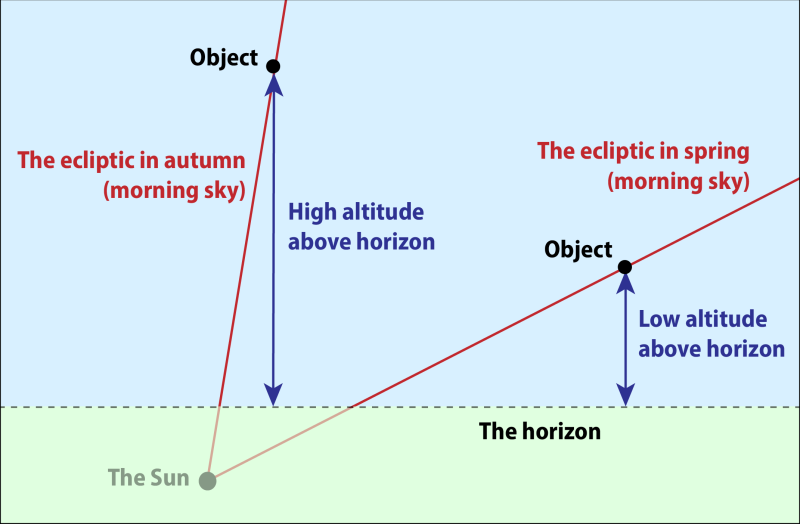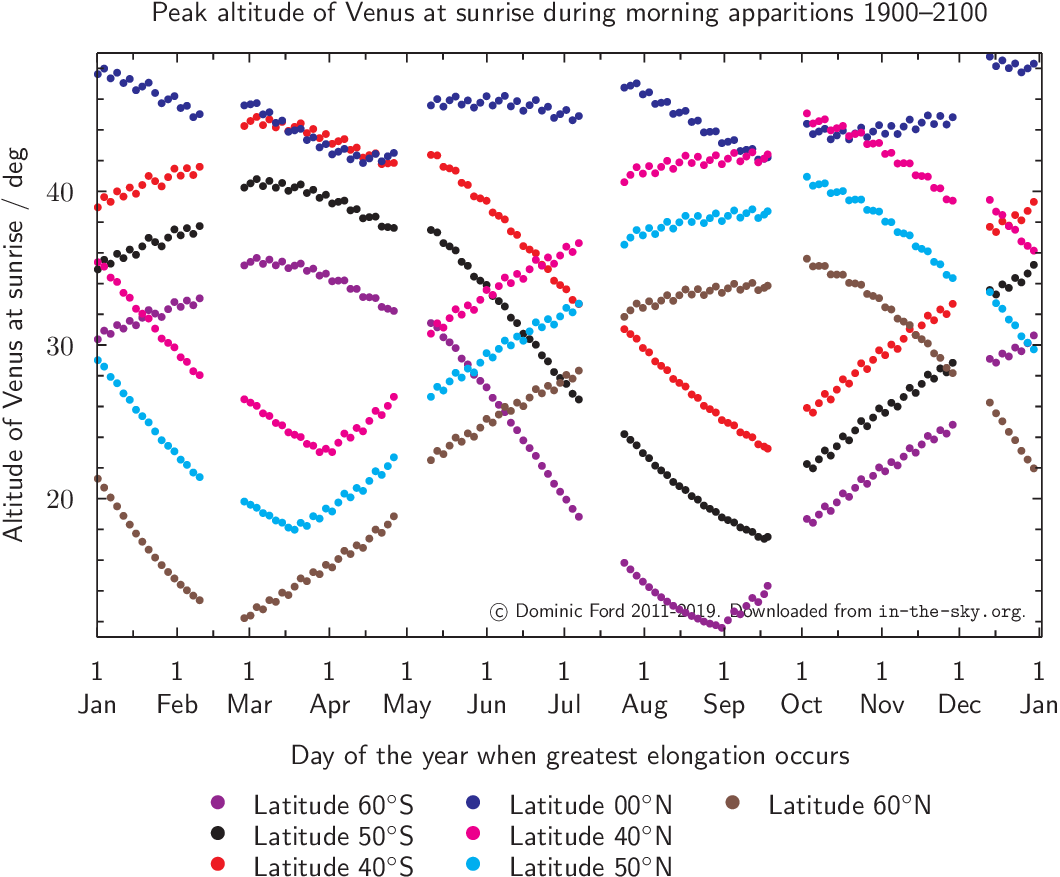As seen from South El Monte , Venus will reach its highest point in the sky in its 2180 morning apparition. It will be shining brightly at mag -4.3.
From South El Monte, this apparition will be reasonably placed and prominent, reaching a peak altitude of 37° above the horizon at sunrise on 7 Aug 2180.
2180 morning apparition of Venus
| 18 Apr 2180 | – | Venus at inferior solar conjunction |
| 22 May 2180 | – | Venus at greatest brightness |
| 27 Jun 2180 | – | Venus at greatest elongation west |
| 28 Jun 2180 | – | Venus at dichotomy |
| 06 Aug 2180 | – | Venus at highest altitude in morning sky |
| 04 Feb 2181 | – | Venus at superior solar conjunction |
A graph of the angular separation of Venus from the Sun around the time of greatest elongation is available here.
Apparitions of Venus
| 01 Jul 2178 | – | Evening apparition |
| 19 Nov 2178 | – | Morning apparition |
| 06 Feb 2180 | – | Evening apparition |
| 27 Jun 2180 | – | Morning apparition |
| 11 Sep 2181 | – | Evening apparition |
| 31 Jan 2182 | – | Morning apparition |
| 18 Apr 2183 | – | Evening apparition |
Observing Venus
Venus's orbit lies closer to the Sun than the Earth's, meaning it always appears close to the Sun and is lost in the Sun's glare much of the time.
It is observable for a few months each time it reaches greatest separation from the Sun – moments referred to as greatest elongation.
On these occasions, Venus is so bright and conspicuous that it becomes the third brightest object in the sky after the Sun and Moon. It is often called the morning star or the evening star.
These apparitions repeat roughly once every 1.6 years, taking place alternately in the morning and evening skies, depending whether Venus lies to the east of the Sun or to the west.
When it lies to the east, it rises and sets a short time after the Sun and is visible in early evening twilight. When it lies to the west of the Sun, it rises and sets a short time before the Sun and is visible shortly before sunrise.
At each apparition, Venus reaches a maximum separation from the Sun of around 48°. However, some times of the year are more favourable for viewing Venus than others. From South El Monte, it reaches a maximum altitude of between 26° and 47° above the horizon at sunrise during each morning apparition, depending on the time of year. During its 2180 apparition, it will peak at 37° above the horizon at sunrise on 7 Aug 2180.
This variability over the course of the year is due to the inclination of the ecliptic to the horizon.
The inclination of the ecliptic to the horizon
At all times, Venus lies close to a line across the sky called the ecliptic, which is shown in yellow in the planetarium above. This line traces the path that the Sun takes through the zodiacal constellations every year, and shows the plane of the Earth's orbit around the Sun. Since all the planets circle the Sun in almost exactly the same plane, it also closely follows the planes of the orbits of the other planets, too.
When Venus is widely separated from the Sun, it is separated from it along the line of the ecliptic. But, at different times of year, the ecliptic meets the horizon at different angles at sunrise. This means that Venus appears at different altitudes above the horizon at different times of year, even if its separation from the Sun is the same.
If the ecliptic meets the horizon at a shallow angle, then Venus has to be very widely separated from the Sun to appear much above the horizon. Conversely, if the ecliptic is almost perpendicular to the horizon, Venus may appear much higher in the sky, even if it is actually much closer to the Sun.
At sunset, the ecliptic makes its steepest angle to the horizon at the spring equinox – in March in the northern hemisphere, and in September in the southern hemisphere. Conversely, it meets the horizon at its shallowest angle at the autumn equinox. Because the seasons are opposite in the northern and southern hemispheres, a good apparition of Venus in one hemisphere will usually be poorly placed in the other.
At sunrise, these dates are also inverted, so that for morning apparitions of Venus, the ecliptic makes its steepest angle to the horizon at the autumn equinox, and its shallowest angle to the horizon at the spring equinox.
The optimum time for an apparition of Venus
For this reason, the day when Venus reaches its widest separation from the Sun (greatest elongation) is not necessarily the same day when it appears highest in the sky at sunrise. Venus typically appears highest in the sky a few days or weeks closer to the autumn equinox than the moment of greatest elongation.
The inclination of the ecliptic plane to the horizon at South El Monte varies between 79° (sunrise at the autumn equinox) and 32° (sunrise at the spring equinox). On August 7, the ecliptic is inclined at 55° to the eastern dawn horizon, as shown by the yellow line in the planetarium above, meaning that this apparition of Venus will be reasonably placed and prominent, reaching a peak altitude of 37° above the horizon at sunrise.
Venus's position
The position of Venus when it reaches its highest point will be:
The coordinates above are given in J2000.0.
The sky on 7 Dec 2025
| The sky on 7 December 2025 | ||||||||||||||||||||||||||||||||||
|
86% 17 days old |
All times shown in PST.
|
|||||||||||||||||||||||||||||||||
Source
The circumstances of this event were computed using the DE430 planetary ephemeris published by the Jet Propulsion Laboratory (JPL).
This event was automatically generated by searching the ephemeris for planetary alignments which are of interest to amateur astronomers, and the text above was generated based on an estimate of your location.
Related news
| 07 Aug 2180 | – Venus at highest altitude in morning sky |
| 26 Jun 2181 | – Venus at highest altitude in evening sky |
| 11 Sep 2181 | – Venus at greatest elongation east |
| 06 Jan 2182 | – Venus at highest altitude in morning sky |
Image credit
© NASA/Ricardo Nunes




